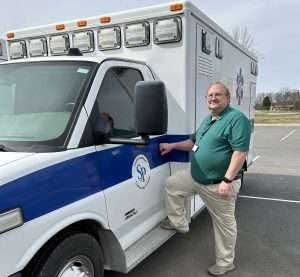Since 2007, South Piedmont Community College’s Chris Floto has dedicated his life to emergency medical services. He worked as a full-time paramedic for 14 years before becoming the College’s lead EMS instructor in 2021.
But for the first 15 years of his career, he worked as a mechanical engineer, designing heating and air conditioning systems for many of the skyscrapers in uptown Charlotte.
How did he go from mapping ductwork to making life-and-death decisions? Floto recently shared his story.
So, explain, how did you start in HVAC but end up in EMS?
I guess the best explanation is that I really like science. I got my undergraduate degree from Pensacola Christian College in mechanical engineering, and for 15 years after I graduated, I designed HVAC systems for most of the major buildings in Charlotte. One of the most unique projects I worked on was The Mint Museum. You know how in your house, when the temperature fluctuates, sometimes the windows will sweat with condensation? There were very strict requirements that this could not happen at The Mint Museum because we had to protect all the historical artifacts. Those were the kinds of challenges I dealt with for 15 years.
When did you get interested in EMS?
I’m a product of that 70s show, “Emergency.” I really liked that show. I was a volunteer firefighter and EMT while I was working as an engineer. After 15 years in engineering, I decided I wanted to do EMS full time. As an engineer, your life is in a cubicle. Occasionally, you go out to a job site that’s under construction, but most of the time, you’re in a cubicle. I grew weary of that way of life. I wanted to be out in the world more, helping people. I got my paramedic certification from Cleveland Community College and became a full-time paramedic in 2007. I went on to hold a good number of positions; for a while, I was the chief of an EMS department in Tennessee. My last job in the EMS field was at Piedmont Medical Center in South Carolina.
HVAC and EMS seem completely different. Is there any common thread between what you did then and what you do now?
The common thread for me is that I like to know what makes things work, whether that’s mechanically in a building or physically in the human body. I want to know how it works, how we can make it better, and how to fix it when things break. Both as an engineer and as a paramedic, my jobs have been about looking at a problem from all angles and finding a solution.
Since going into EMS full time, you’ve amassed quite a number of certifications. Tell us more about your education.
After I got my paramedic certification, I knew I eventually wanted to get into EMS education. I earned my Master of Education from Liberty University, and in May, I’ll graduate with my master’s in emergency medical science from Creighton University. I am licensed as a paramedic in both North and South Carolina, and I also have my National Registry of Emergency Medical Technicians certification. I have two levels of paramedic instructor certifications, a national EMS teaching certificate, and a whole host of specialty certifications, including CPR, Advanced Cardiac Life Support, Pediatric Advanced Life Support, Advanced Medical Life Support, Pre-hospital Trauma, and Emergency Vehicle Operator Safety.
Why did you want to go into teaching?
The paramedic life is challenging. You’re working in the rain, snow, cold, the middle of the night. It never ends for EMS. It is a vital and fulfilling career, but it does take a toll. I really like helping people, and I realized that in teaching, I could actually affect more people than I could in the field. When I was a paramedic, if I was able to help one patient, that was a good day. Now, I am teaching a bunch of students, and they’re all going into the field and taking care of all their patients. I’m getting to make more of a difference as an instructor.
Is there an area of EMS you want to gain more knowledge in next?
Community paramedicine is all the rage now. We want to eventually offer that here at South Piedmont, so I’ll need to get certified to teach it. Community paramedicine really became a thing during the pandemic; it’s a link between hospitals and patients. It involves paramedics visiting a patient’s house, administering medications, checking the patient’s progress, communicating with the physician, and making adjustments to the patient’s care plan. It is used for people who have chronic medical conditions and need regular healthcare that’s more complex and involved than what they might get from a home health worker.
EMS has become a family tradition of sorts, correct?
My son, Kurt, got his paramedic certification from South Piedmont, and he now works as a paramedic in Carrabus county. Having him become a paramedic has taught me to see EMS from a different angle. We see some really difficult things as paramedics, and it can wear on your psyche. I’m always encouraging him to prioritize his mental health, and now I talk a lot about wellness in my classes. I try to impart to my students that it is OK to feel bad after a difficult call, and that it’s important to express your feelings so you can continue to do your job. When I started in 1990, it was “suck it up and keep going.” We’ve come a long way in the EMS field.


